George Town - Cat Island - Cape Eleuthera
March 24 - March 30, 2001
Early on the 24th we weighed anchor to make our way out through Conch Cay Cut to Cat
Island. It was an exodus. Very few boats had left during the preceding week
due to the weather. We estimate that on the day we departed, there were about 60
boats leaving George Town. Twenty or so were headed east and south to Rum Cay, then
on to the Caribbean. A handful were headed south to the Jumentos then on to Cuba.
The vast majority were headed back up through the Exumas toward Nassau and then
home to the U.S.
 No one else seemed to be on our course for Cat
Island. It was a beautiful, sunny day for the 55 mile sail over to New Bight at the
southern end of Cat Island. We sailed on a close reach all day. It was one of
the best days of sailing on the entire trip, but maybe I say that about every day that we
sail. As we sailed across Exuma Sound we could hear on the radio the other boats
headed up the Exumas. They didn't have it as nice as us. Those who could do
it, had to sail close hauled, hard on the wind. Others had to motor since they
couldn't point high enough to sail. Eventually the wind died for most of them.
It wasn't until we were in the lee of Cat island that the wind got light and shifty.
But since we were only a few miles from our destination we didn't mind turning on the
engine.
No one else seemed to be on our course for Cat
Island. It was a beautiful, sunny day for the 55 mile sail over to New Bight at the
southern end of Cat Island. We sailed on a close reach all day. It was one of
the best days of sailing on the entire trip, but maybe I say that about every day that we
sail. As we sailed across Exuma Sound we could hear on the radio the other boats
headed up the Exumas. They didn't have it as nice as us. Those who could do
it, had to sail close hauled, hard on the wind. Others had to motor since they
couldn't point high enough to sail. Eventually the wind died for most of them.
It wasn't until we were in the lee of Cat island that the wind got light and shifty.
But since we were only a few miles from our destination we didn't mind turning on the
engine.
As usual, it was Christopher's job to rig the fishing rods. You can see that he
chose the right lure. This Mahi-mahi was beautiful as he brought it along side. When
these fish are in the water and fighting the hook and line they flash brilliant yellows,
blues and silvers.
As beautiful as his fish was, the water colors continued to amaze us. In the
morning we left behind the light blues of Elizabeth Harbor for the cobalt blue of Exuma
Sound. As we neared the end of the trip Cat Island began to appear as a thin dark
strip on horizon. Slowly a thin strip of pale blue to lime began to appear between
the cobalt blue of the Sound and the strip of land that was Cat Island. As we got
closer the strip became a more intense pale blue and slowly grew in width until the bank
on the west side of Cat Island stretched before us. The transition from the Sound to
the bank is abrupt. In less than a mile the bottom comes up from several thousand
feet to twenty feet of water over a white sand bottom. It was the white sand bottom
reflecting the sunlight back through the water that had produced the beautiful blue-green
strip that we saw on our approach.
After we got to New Bight we were joined by 'Ocean Explorer'. Johnson, Wendy,
Pete and Will were coming in from Little San Salvador. By the end of the afternoon
there were a total of five boats in the anchorage. What a relief from George Town!
The radio was silent for long periods. No roll and chop from dinghies speeding by.
No loud music thumping from the clubs on shore.
We asked the crew from Ocean Explorer to come over for dinner to share in our bounty
from the sea. Christopher's fish fed all six of us, with seconds for all.
New Bight is the home of The Hermitage, built by Father Jerome. The padre was
trained as an architect in England, became an Anglican priest, then a Catholic priest.
He served in Australia, the Bahamas and the U.S. as a missionary. He retired
from life as a missionary when he had a heart attack. It was then that he went to
Cat Island and built his retirement home, The Hermitage. One thing led to another
and he built other churches on Cat Island, Long Island, Eleuthera and New Providence.
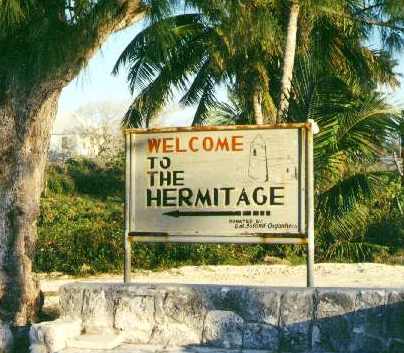 |
This is the sign that directs you to Father Jerome's abode from the road
along the beach and anchorage. |
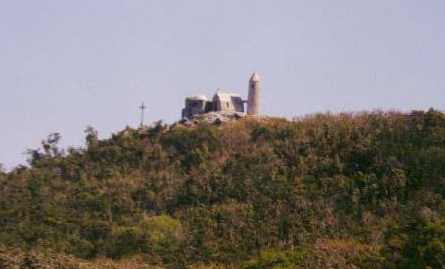 |
The view from the road below the anchorage. |
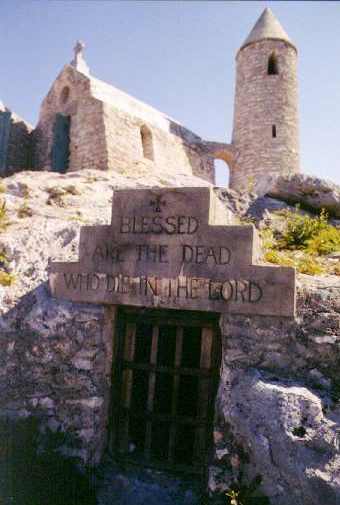 |
While the Hermitage was under construction father Jerome lived in this
cave. |
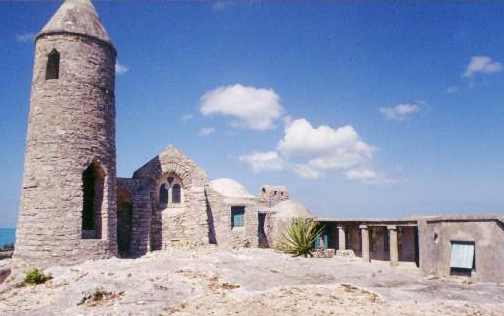 |
The back side of the Hermitage. Below and to the left of the bell tower is
a catchment system carved from the rock that Father Jerome used to collect rainwater. |
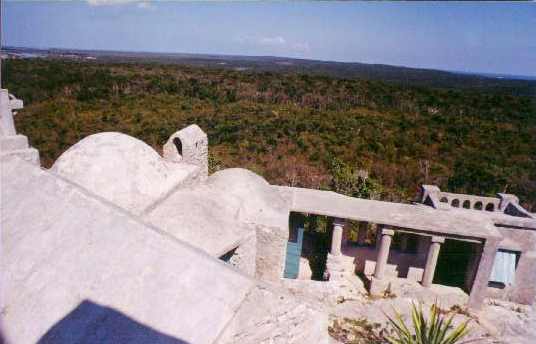 |
The view over Cat Island from the bell tower. |
The first afternoon in New Bight we hiked up to the Hermitage with Johnson and Wendy
and their boys to watch the sunset. To our delight we were treated to the green
flash as the sun finally sank below the horizon. The second such flash of our trip.
With its better top soil and rainfall and agricultural history I expected Cat Island to
be properous, by Bahamian standards. That is not the case. The tourist resorts
that have been flattened by hurricanes in the last 10 - 15 years have not been rebuilt.
There is not much agriculture anymore. Many of the businesses at New Bight
have been shuttered for a long time. These observations put me in a contemplative
mood.
By training I am an economist. By nature I am pretty conservative; for a baby
boomer anyway. I understand the importance of free trade and comparative advantage.
Nevertheless, it seems that the 'first world' is so productive that we can produce
and sell food in the Bahamas for less than the Bahamians can produce it themselves.
The Bahamians have no resource base for manufacturing. Basically, our productivity
and natural resources have undercut anything they can do except for tourism. Sandy
beaches and sunshine are where they have a comparative advantage. Yet, their own
government has made it too hard for foreigners to develop tourism and there aren't enough
wealthy, entrepreneurial locals to really bring 1st world resorts on-stream. Apart
from that, the resort developers keep finding other exotic locales in other parts of the
world with an even lower cost of doing business. In short, there is always another
3rd world country with an even greater comparative advantage in tourism.
At the same time we in the 1st world have closed our borders to all those we have put
out of work with our fantastic comparative advantage in processed goods. When the
locals are able to find a crop they can produce for export (sugar, bananas, oranges,
pineapple) then we impose tariffs in order to undermine their comparative advantage.
Trying to escape complete reliance on tourism, the Bahamians tried to develop off-shore
banking. After all, in relative terms they can provide banking services as cheaply
as anyone. But the U.S. has led the OECD and WTO to threaten sanctions unless the
Bahamians meet reporting rules not imposed in the U.S., but which we claim are necessary
in our fight against drugs.
In short, we have used our comparative advantage in many goods and services to dominate
an economy like the Bahamas, then erect trade barriers that prevent them from exploiting
their own comparative advantage, and then restrict the mobility of their labor force to
regions where the jobs are.
| This Catholic Church in New Bight was designed and built by Father Jerome. |
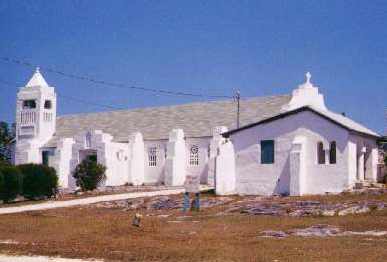 |
| These are two views of an abandoned Anglican Church in New Bight. A
high proportion of the buildings along the beach and anchorage in New Bight are now in
this state. In the days of a larger more robust agricultural economy I'm sure that
this church was alive and vibrant. |
 |
|
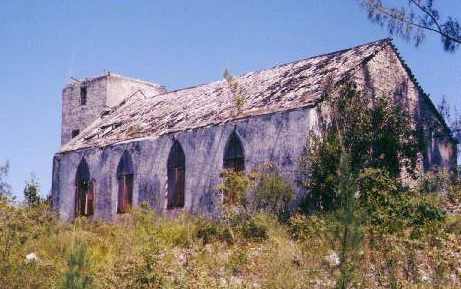 |
With the threat of yet another cold front we opted for an extra day in New Bight.
The extra day provided lots of time to discuss the unemployment we saw in this
slice of paradise. This bit of beach and mountain is a pretty place indeed.
The Hermitage and some of the other churches could be developed as part of a pilgrimage
tour. All that is needed is a 1st class hotel nearby. As part of the
development process the government could create a BahamasAirPass, akin to the Eurail pass,
good for travel throughout the islands during a limited time. Wendy's advice to me and
Johnson was that we stop trying to interpret the Bahamian quality of life on our own terms
and just enjoy the tranquility and people.
On this extra day here We were not able to find any good spearfishing locations. Either
we didn't know where to look, or our dinghy was too slow. It was Will's thirteenth
birthday and he graciously shared his cake with us. In the evening we were treated
to another green flash.
 On 3/27 we made our way up to Bennett's
Harbor. It was a dead calm day and we motored the entire 25 miles.
Boring. The choices for the day's destination were somewhat limited. The few
harbors on the west side of Cat Island are only big enough to fit a few boats
inside. Little San Salvador is not a place to be in anything but the prevailing (?)
easterly winds. Bennett's Harbor seemed the best choice in light of a forecasted
approaching cold front. Outside the harbor we would be protected from winds blowing
from NNW through SSW. If necessary we could squeeze into the harbor. We got up
there early. While Christopher went spearfishing,successfully, I hiked across the
island to the Atlantic Ocean.
On 3/27 we made our way up to Bennett's
Harbor. It was a dead calm day and we motored the entire 25 miles.
Boring. The choices for the day's destination were somewhat limited. The few
harbors on the west side of Cat Island are only big enough to fit a few boats
inside. Little San Salvador is not a place to be in anything but the prevailing (?)
easterly winds. Bennett's Harbor seemed the best choice in light of a forecasted
approaching cold front. Outside the harbor we would be protected from winds blowing
from NNW through SSW. If necessary we could squeeze into the harbor. We got up
there early. While Christopher went spearfishing,successfully, I hiked across the
island to the Atlantic Ocean.
Bennett's Harbor is another of those Bahamian places that could be so much more with a
little energy. First, they have to get the derelict boats out of the harbor, like
this abandoned gaff rig sloop from Haiti in the above picture. Parenthetically, this boat
is identical to the one on the beach at Little Farmer's Cay and that reportedly brought
130 Haitians to the Bahamas. They need to fix up the government dock and buildings.
And they need to provide some minimal services to visiting yachts.
The expected cold front didn't seem to be materializing so we went over to Little San
Salvador on 3/28. The fifteen miles was on a broad reach or wing-and-wing all the
way. Previously uninhabitied, Little San Salvador was purchased not too long ago by
Holland America Cruise Line. The ship company has now made it a day destination for
its cruise ships. One of their ships will come into the bay, disgorge a couple of
thousand passengers for a picnic and water sports, load everyone back on board late in the
afternoon and then sail away in the evening. It is supposed to be quite a sight.
Between ship visits the site is a well maintained ghost town.
We only stayed at Little San Salvador for one night, so we missed the cruise ship
spectacle. We had to move on because the forecasted cold front was heading our way.
The storm producing the front was already making itself felt at our anchorage.
The wind was a little too far north of east and the ocean swells were wrapping
around the island into the anchorage, making life on board very uncomfortable. On
3/29 it was on to Eleuthera.
 No one else seemed to be on our course for Cat
Island. It was a beautiful, sunny day for the 55 mile sail over to New Bight at the
southern end of Cat Island. We sailed on a close reach all day. It was one of
the best days of sailing on the entire trip, but maybe I say that about every day that we
sail. As we sailed across Exuma Sound we could hear on the radio the other boats
headed up the Exumas. They didn't have it as nice as us. Those who could do
it, had to sail close hauled, hard on the wind. Others had to motor since they
couldn't point high enough to sail. Eventually the wind died for most of them.
It wasn't until we were in the lee of Cat island that the wind got light and shifty.
But since we were only a few miles from our destination we didn't mind turning on the
engine.
No one else seemed to be on our course for Cat
Island. It was a beautiful, sunny day for the 55 mile sail over to New Bight at the
southern end of Cat Island. We sailed on a close reach all day. It was one of
the best days of sailing on the entire trip, but maybe I say that about every day that we
sail. As we sailed across Exuma Sound we could hear on the radio the other boats
headed up the Exumas. They didn't have it as nice as us. Those who could do
it, had to sail close hauled, hard on the wind. Others had to motor since they
couldn't point high enough to sail. Eventually the wind died for most of them.
It wasn't until we were in the lee of Cat island that the wind got light and shifty.
But since we were only a few miles from our destination we didn't mind turning on the
engine. 







 On 3/27 we made our way up to Bennett's
Harbor. It was a dead calm day and we motored the entire 25 miles.
Boring. The choices for the day's destination were somewhat limited. The few
harbors on the west side of Cat Island are only big enough to fit a few boats
inside. Little San Salvador is not a place to be in anything but the prevailing (?)
easterly winds. Bennett's Harbor seemed the best choice in light of a forecasted
approaching cold front. Outside the harbor we would be protected from winds blowing
from NNW through SSW. If necessary we could squeeze into the harbor. We got up
there early. While Christopher went spearfishing,successfully, I hiked across the
island to the Atlantic Ocean.
On 3/27 we made our way up to Bennett's
Harbor. It was a dead calm day and we motored the entire 25 miles.
Boring. The choices for the day's destination were somewhat limited. The few
harbors on the west side of Cat Island are only big enough to fit a few boats
inside. Little San Salvador is not a place to be in anything but the prevailing (?)
easterly winds. Bennett's Harbor seemed the best choice in light of a forecasted
approaching cold front. Outside the harbor we would be protected from winds blowing
from NNW through SSW. If necessary we could squeeze into the harbor. We got up
there early. While Christopher went spearfishing,successfully, I hiked across the
island to the Atlantic Ocean.